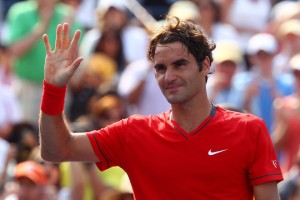By Thomas Swick
swickt@bellsouth.net
September 3 was Polo Ralph Lauren Day at the U.S. Open, but the name that came to my mind was Charles Darwin. The day’s schedule clearly showed the survival of the fittest that was taking place before our eyes, with only eight of the courts scheduled for matches.

On the Grandstand court Francesca Schiavone took out Chanelle Scheepers, who was wearing an interesting combination of garnet and gray (my high school’s colors). Some of Schiavone’s fans stayed for the next match between her compatriot, Roberta Vinci, and Andrea Petkovic.
A ruggedly handsome man arrived and sat two rows in front of me. He looked like a familiar actor, and I tried to think what movies I’d seen him in. Then I noticed the U.S. Open polo shirt he was wearing and realized that he was the chair umpire I’ve seen on TV officiating at Grand Slams. (Clearly a sign I’ve watched far too much tennis.)
The man sitting behind me was a German journalist. I asked him if Petkovic still writes a column for a newspaper in Germany.
“She used to,” he said. “But she doesn’t anymore.”
“How was her writing?” I asked.
“Very good,” he said. “Very professional. Better than some of our colleagues’.”
Petkovic was rolling. At 5-love in the second set, I noticed that MaliVai Washington had appeared in the tunnel, waiting to step onto the court for the post-match interview. It must be terribly discouraging to be down love-5 and to see out of the corner of your eye the interview team already waiting in the wings. Like catching a glimpse of the tournament Grim Reaper.
Back at the media center I asked about the Federer press conference.
“It’s at 4:45,” the woman at the player information desk said.
“In interview room 1?” I asked.
“He’s always in 1,” she said.
Federer was late but his father was there (my second father sighting of the Open) in bright red shirt and red RF cap. (Bob and I had discussed the absurdity of that logo, and the even greater absurdity of people who are not Roger Federer wearing it.)
There were enlarged photos on the wall, of Jimmy Connors and Chris Evert, and the backdrop to the podium was a busy montage of American flags, U.S. Open logos, and dark blue shots of Arthur Ashe Stadium.
Federer walked in at about 5:15 and sat unenthusiastically in front of the microphone. Though his answers were long and fairly candid and intermittently, characteristically, self-congratulatory. When asked about the high number of players retiring this year, he said that five-set matches have a way of revealing injuries that have been there all along, then added: “I have never retired in my whole life except once when I played James Blake in Paris, but I didn’t even walk on the court.”
Someone asked about his facility with languages, and he said he enjoys being able to switch easily from German to English to French. Though he noted that the drawback is, it makes his press conferences longer.
After about 15 minutes, as illustration, the woman at the podium asked for questions in German and French. And all of a sudden Federer seemed to relax, putting his cap on (backwards), leaning back in his chair and crossing his legs.
There was nothing relaxed, a few hours later, about the atmosphere in the Grandstand, where Jo-Wilfried Tsonga was getting the upper hand in a slugfest with Fernando Verdasco. The stadium was packed, the fans clearly in the mood for a classic night match, but Tsonga wasn’t going to oblige. At the start of the third – and final – set, a man sitting along the baseline four rows up, wearing a salt-and-pepper beard and an Indianapolis 500 cap, began shouting maniacal encouragement to Verdasco.
“COME ON NANDO! GET UP IN HIS FACE! GET SOME! SATURDAY NIGHT!”
After Tsonga aced him for a 5-3 lead, Verdasco spit in disgust on the court.
“LET’S GO NANDO! HE’S GOOD! YOU’RE BETTER!!”
The man was not only loud but wrong.
After the match, the man sitting behind me (and in front of the screamer) said something in Spanish to a woman standing in the aisle.
“What did he say?” I asked her.
“He said that he prayed to God to strike the man with lightning.”
That’s another way of thinning the numbers.
